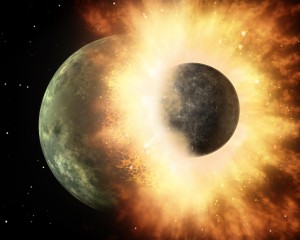
Artist’s depiction of a collision between two planetary bodies. From https://en.wikipedia.org/wiki/Giant_impact_hypothesis.
We read a fun paper in journal club today, written by Inamdar and Schlichting of MIT that looks at the impact of large impactors on the atmospheres of gas-rich exoplanets.
Among the surprising discoveries of exoplanet searches is a huge class of gas-rich planets between Neptune and Earth in size. Called sub-Neptunes or super-Earths, standard models for planet formation predict these planets shouldn’t exist — either they should have remained as small as the Earth as they accreted or they should have quickly grown to the size of Jupiter or Saturn. We don’t have planets like these in our solar system, but they may be one of the most abundant type of planet in the galaxy.
Even harder to understand, sub-Neptunes display a very broad range of densities, with some having densities greater than Earth’s and others with the density of wind-packed snow. This diversity indicates some planets have large rocky/icy cores with just a little gas on top, while others have tiny cores with bloated hydrogen/helium atmospheres. Since we think gaseous planets all form more-or-less the same way, it’s hard to explain this wide range of internal structures.
Inamdar and Schlichting explore the possibility that giant impacts between young planets in these systems could account for this diversity. By applying a simple 1-D hydrodynamic model, they show that these massively violent collisions could easily remove large amounts of atmosphere from the young planets.
Whether a certain planet experienced such a collision depends in a stochastic way on the initial conditions and gravitational interactions in these chaotic young planetary systems. So some planets would have experienced large collisions that removed a lot of their atmospheres, giving a high mean density, while others didn’t, leaving them low-density.
These same kind of planetary collisions shaped the diversity of planets in our own solar system. For example, the Earth’s Moon formed as the result of a collision between the proto-Earth and Mars-sized object, named Theia. Uranus probably got its unusual tilt from a collision with an Earth-sized object early in its history.
So even though most extrasolar planetary systems we know about don’t resemble our own, the results from this study show the same processes shaped them, and planets everywhere probably experienced a violent adolescence.
Journal club attendees today included Jennifer Briggs, Karan Davis, Hari Gopalakrishnan, Tyler Gordon, Emily Jensen, and Jacob Sabin.